Announcing Azure Functions, Microsofts AWS Lambda competitor
Azure Functions (Preview) is the long awaited competitor of AWS Lambda allowing you to run small pieces of code and only having to pay for what you’re using. It uses a event driven model where you connect data sources -from the cloud or on-prem- and (re)act on certain events in an easy-to-use way.
You can either choose to use Continous Deployment & Integration or use the interactive portal to visualize the Triggers, Inputs & Outputs of your functions.

You can write functions in a variety of languages going from Node.js & Python to Bash & PowerShell to C# and others, they even support pre-compiled executables. Here is a small example of code used in a Function.
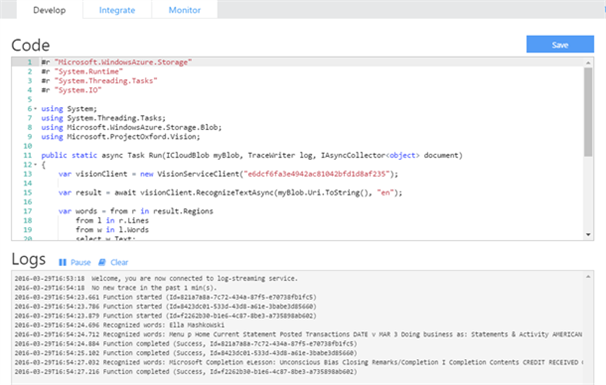
People who have been working with Azure Web Jobs can see some similarities but the differentiator here is that with Azure Functions you only pay for the compute you use while with Azure Web Jobs you run on an App Plan that is billed per hour.
Azure Functions provide a variety of ways to trigger your functions: Timer-based, webhooks, events from other services i.e. message in Service Bus Queue, etc. allowing you to use them in a variety of scenarios.
From an integration/IoT perspective this is a very nice service where we can use this in a combination with other services. We could react on events in an on-prem SQL database and trigger processes in the cloud. One could trigger them from within a Logic App as a substep of the business process, etc…
Interested in knowing how it works under the hood? Check this //BUILD/ session!
Here is a nice comparison between Azure Functions & AWS Lambda by Tom Maiaroto
But keep in mind – This is only a preview!
Extended Device Management in Azure IoT Hub
Microsoft announced that Azure IoT Hub will have extended Device Management features in the near future enabling us to more easily manage our devices, perform health checks, organise devices into groups, and so on, by exposing several server-side APIs:
- Device Registry Manager API
- Device Groups API
- Device Query API
- Device Model API
- Device Job API
What I personally like the most is that I can now define the information model of devices & entities taking the management a step further. In the past a device ID was only linked to access keys without any metadata – Those days are over!
Announcing Azure IoT Gateway SDK
Following Microsofts Internet of Your Things they’ve announced the Azure IoT Gateway SDK that helps developers & ISVs build flexible field gateways where they can implement edge intelligence to process data before it was even sent to the cloud. This allows us to for example to encrypt our data before sending it over the wire to improve the security of our solutions.
This is really great because it allows us to save cost/time on the gateway part and focus on connecting our devices to the gateway or analyse & process our data in the cloud!
Cortana Analytics Suite is no more, meet Cortana Intelligence Suite!
Last year Microsoft announced the Cortana Analytics Suite, the flagship for building intelligent applications in the cloud or devices based on the (big) data analytics.
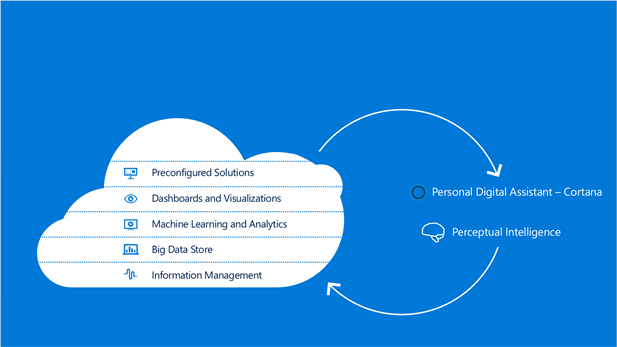
At //BUILD/ Microsoft took it a step further and rebranded the Cortana Analytics Suite to Cortana Intelligence Suite!
Next to Cortana the Cortana Intelligence Suite also has two new additional “Intelligence” feature/services:
- Microsoft Bot Framework enables you to create your own intelligent agents, or bots, to use in your applications to make it feel more natural. After taking a quick look it feels like the idea is to create a WebAPI that is being deployed in Azure as an API App.
- Project Oxford is now being offered as a service called Azure Cognitive Services (Preview). It is a collection of APIs-as-a-Service that enable you to make your applications more intelligent and contains the following APIs at the moment:
- Language – Web Language Model, Text Analytics & Language Understanding Intelligent Service API
- Vision – Face & Emotion API
- Knowledge – Recommendation API
- Speech – Speech API
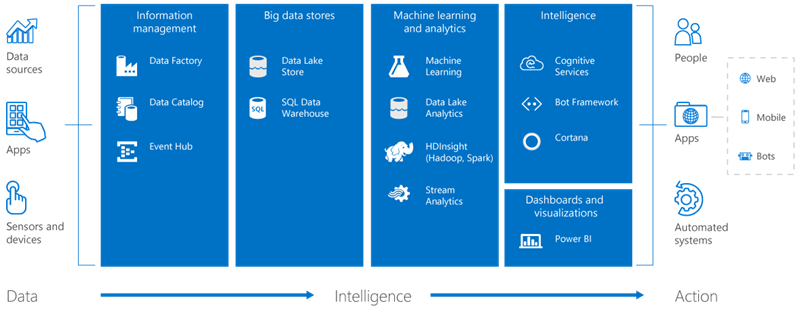
Want to become intelligent yourself? Read more about Azure Cognitive Services here and here.
Azure Data Catalog is now General Available
Azure its enterprise-grade metadata catalog, Azure Data Catalog, is now General Available! Data Catalog stores, describes, indexes, and shows how to access any registered data asset. It enables collaboration on data within the corporation and to make data discovery super easy.
In the new pricing, the limitation on the maximum amount of users in the Free plan is gone & it comes without saying that you really need to have a catalog when your working several data sources, certainly in an IoT solution.
Read the official announcement by Julie Strauss here.
Announcing Azure Power BI Embedded
Microsoft introduced Azure Power BI Embedded, a service that allows you to use embedded interactive visuals in your apps & websites. This allows you to use Power BI Desktop to create reports without having to write any code for the visualization or reporting in your app.
However it’s not 100% clear to me how Power BI Embedded relates to Power BI – Is the vision for Embedded to focus on the end user and save developer time while Power BI is focussed for internal usage & data engineers? To be continued…
Here is a small introduction on Azure Power BI Embedded and how you authenticate it against a back-end.
Announcing Azure Storage Service Encryption preview
All new Azure Storage accounts using the Azure Resource Manager now have to possibility to enable Azure Storage Service Encryption (preview). Azure Storage Service Encryption will encrypt all your Blob Storage data-at-rest using the AES-256 algorithm.
You don’t need to do anything as this is a managed service where Microsoft will manage the complete process.
Read the full announcement here.
Partitioned collections in DocumentDb across the globe
The DocumentDb team has made several announcements about their service, let’s have a look!
For starters: they have a new pricing model that seperates the billing for storage from throughput. Your indexed storage will be billed for each GB per hour that you store while the throughput is based on the throughput units (RU) you’ve reserved per hour.
With the new Global Databases you can take it a step further and replicate your data from one region to several others allowing you to move your data as close to the consumer as possible. This improves the high-availability of your application and offers a fail-over mechanism.
DocumentDB Global Databases is currently in public preview.
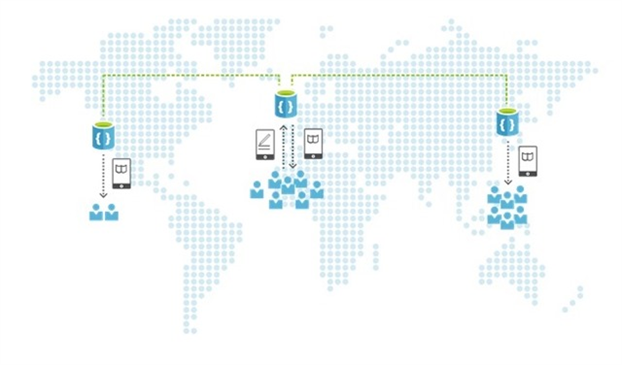
When creating a new DocumentDB collection, you now have the option to create a Single Partition or Partitioned Collections. The partitioned collection allows you to specify a partition key enabling you to store up to 250 GB of data and up to 250 000 request units per second or even increase it more by filing a support ticket.
Last, but not least – DocumentDB now supports using the Apache MongoDB APIs & drivers allowing you to use your existing MongoDb skills & tools to work with DocDb. Because of this you can now use Parse in Azure with DocumentDb.
Here are some additional resources:
- DocumentDB goes planet scale with global databases, new pricing and more developer choices
- DocumentDB: Partitioned collections for higher storage and throughput
Service Fabric going General Available with preview for Windows Server & Linux support
Service Fabric is now General Available and ready to use in production on Azure! Using Service Fabric is free of charge however you’ll need to pay for the compute, network & storage that you are using.
For those who have missed last years announcement – Service Fabric is a microservice application platform that allows you to build reliable services & actors in a distributed way. The platform will handle applicationh update/upgrades for you out-of-the-box and is heavily using inside of Microsoft with internal customers such as Azure SQL Databases, Azure DocumentDB, Intune, Cortana and Skype for Business.
Microsoft also announced the public preview of the standalone Service Fabric on Windows Server allowing you to use Service Fabric on-premises or in other clouds. Next to Windows Server, it will also be available on Linx starting with a private preview.
Last, but not least – The runtime has also been improved and the GA SDK is available. Remarkable is that you can now also debug a cluster in Azure from within Visual Studio.
I bet you’d love to read more! Read more about these announcements & improved developement experience here or if you want to learn more about Service Fabric here.
But wait, there is a more!
Here are some small tips/reminders:
- Azure App Service Advisor now monitors your App Plan giving you recommendations on the resources i.e. to scale out to provide more resources & keep running smoothly. This feature is enabled by default as of last week. Check out this Azure Friday episode if you want to learn more.
- MyDriving is an Azure IoT & Mobile sample that uses Azure services to build a solution scalable, performant, highly available, and cross platform IoT service and application. The sample comes with a +/- 150 page long guide on how they’ve built it. Read more here if you want to learn more about it.
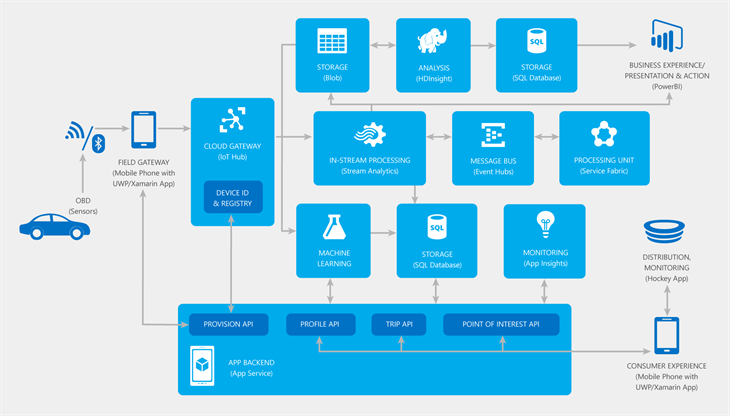
- A small reminder that Azure Managed Cache Service & Azure In-Role Cache will be retired on November 30, 2016
Still want more? Don’t forget to browse all the recordings of the event here.
Thanks for reading,
Tom.
Subscribe to our RSS feed